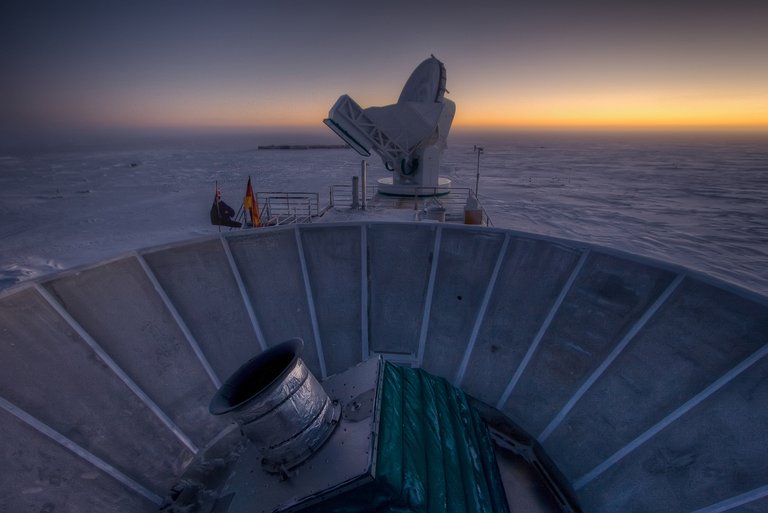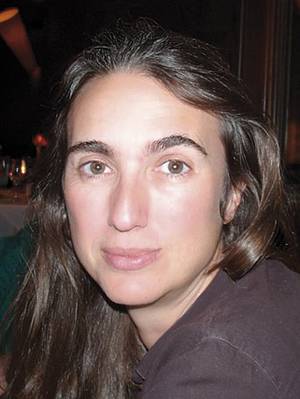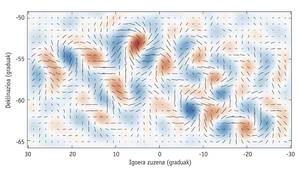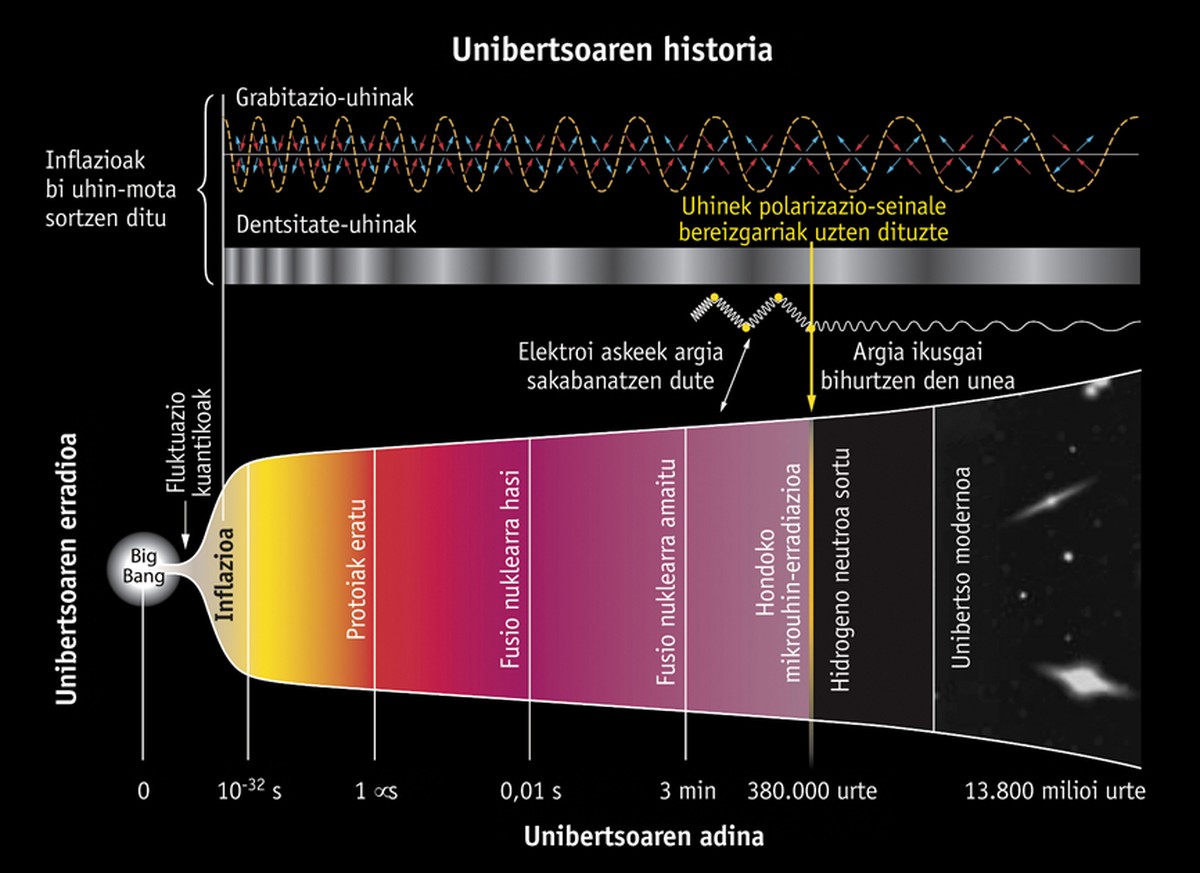The appearance of a footprint that confirms inflation in the origin of the universe has provoked a confusion
--> Updated on 20/03/2014 with an interview with cosmologist Ruth Lazkoz.

The journal Nature has used the same word in the news and highlighted that the discovery includes three main contributions: “It provides the most direct evidence of the waves announced by Einsten; it is the proof of cosmic inflation that physicists eagerly awaited; and it opens the way to harmonize the basic forces of nature with quantum gravitation.”
John Kovack, researcher at the Harvard-Smithsonian Astrophysics Center and head of the BICEP2 team, explains what they have achieved: Traces of gravitational waves after the Big Bang have been detected in the microwave background radiation. This footprint is a certain type of polarization, called mode B.
The astrophysics of the Institute of Astrophysics, Optics and Electronics of Mexico, Itziar Aretxaga, has remembered that several groups work in the detection of polarization type B, such as SPT, ABS, ACTpol and terrestrial telescopes CLASS, EBEX, SPIDER and PIPER Planck satellite balloons. And all of them, apparently, have been advanced by the BICEP2 telescope team.
All have the same objective, according to Miguel Querejeta, astrophysicist at the Max Planck Institute: to detect gravitational waves, which are the proof that corroborate the theory of inflation proposed by Alan Guth in the 1980s.
Inflation, elegant theory

In fact, as Aretxaga says, “inflation has not been tested so far, but it is necessary to solve some problems in which the classic theories of the Big Bang are found.” Among these problems is the uniformity of the temperature of the microwave background radiation: “Microwave background radiation has a very similar temperature (2.7K) measured in any direction, but if this radiation occurred at the 380,000 years of the universe, there is actually no time to balance the temperature throughout the universe, as information cannot be transmitted at a speed higher than that of light. Inflation gives a very elegant solution to this problem.”
The theory of inflation proposes that in about 10-35 seconds after the Big Bang, the universe multiplied by 1040. “In fact, if this were so, the places that release microwave radiation from the background would be 1040 times closer than in the classic calculation before inflation occurs, so there would be no problem in achieving thermal equilibrium.”
According to Alan Guth, inflation would be the “Big Bang Banga”. According to the theory, this rapid and enormous expansion of space time would be accompanied by gravitational waves that would leave a mark on the background microwave radiation: Polarization type B.
There are two types of polarization, modes E and modes B. The first ones can be produced by gravitational waves, but also by other phenomena related to the matter present in the universe. On the contrary, it has been considered that the B modes can only be created by the original gravitational waves, although in the detection carried out last year with the SPT telescope can also be produced by the lenses they saw. However, discarding that it is for lenses, the discovery of this type of polarization would show that there are gravitational waves and that, in turn, the theories that predict them are correct.
Given the evidence that the theory affirms
Several groups sought, therefore, a polarization like B, and that is why Andrei Linde was so excited, a physicist who completed Guth's proposal when they informed him that they had detected it. And no wonder: as he said, it took 30 years to wait for the proof that would ratify the theory: The Big Bang created the footprint of the original waves. In statements made upon receiving the news, Lind acknowledged that he was afraid to believe it was true because he was “only beautiful.” To escape this fear, it has also been useful to detect polarization like B.
In addition to Linde, many other physicists, astronomers and cosmologists have rejoiced at the news. Although Aretxabaleta had a holiday, he spent the whole day in front of the computer: “First, trying to listen to the technical speech by streaming, but I couldn’t do it because the Harvard server was collapsed, then I waited for the press conference and got me to realize it live, and finally read the technical article and read and commented on the comments of other astrophysicists and cosmologists on social networks.”
The current news recalls the period in which temperature fluctuations in microwave background radiation were detected in 1992: “Then I was doing the thesis in Madrid and the professors of my department were at the door, giving the news, totally agitated. This result of 1992 appeared on the first page of all newspapers and, subsequently, in 2006, was awarded the Nobel Prize in Physics to the main researchers of the groups that made the discovery, after having confirmed the discovery well.” He believes the same has happened with the Higgs boson, but this time it is considered even more “exciting”, since the theory of inflation was not as accepted as the previous two.
For Miguel Querejeta it has also been “rewarding” to collect the discovery. However, he warns that some media have exaggerated and distorted the news: “For example, my fellow athletics were asking me if this is the definitive test of the Big Bang… but we were clear that it was the Big Bang since 50 years ago Penzias and Wilson discovered the background microwave radiation.”
Pending confirmation
But with joy, both Aretxaga and Querejeta have expressed caution. BICEP2 researchers have recognized that another group should confirm the detection to fully validate it. And that same Aretxaga thinks: “This would give certainty to the result. They can also clarify some strange effects that are observed in the data.”
The BICEP2 group has stated that “it is quite clear that a polarization of the type B has been detected”, “and has stated that it is not a polarization of the type B caused by the amplification of the microwave background radiation and the matter between us, but that it will have to be confirmed.”
In addition, it considers that the intensity of gravitational waves and the type of inflation that can be is not yet defined. Even more: “The comparison between data and models is still not very good at some scales and perhaps the key is in the processing of data. They can be details, but you have to understand the details well before such a great discovery.”
Querejeta has also considered it essential that other groups obtain results and with them confirm the detection of bicep2: “On the one hand, to know better the characteristics of the type of inflation it will be necessary to deepen the study of the microwave background radiation, for which we can expect new results of the Planck satellite. On the other hand, it would be interesting to perform other detections of gravitational waves. In fact, gravitational waves have to do not only with inflation, but with any situation in which space time is very curved, for example, around black holes; and in this direction there are several groups of researchers working.”
According to Aretxabaleta, “we will have to have a little patience until the other groups carry out their work”.
Buletina
Bidali zure helbide elektronikoa eta jaso asteroko buletina zure sarrera-ontzian















